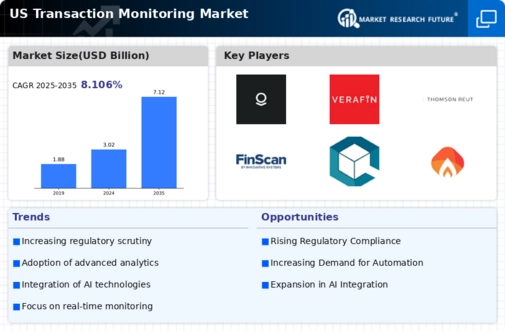Regulatory Landscape Changes
The regulatory environment surrounding financial transactions is becoming increasingly complex, necessitating advanced transaction monitoring solutions. In the US, regulatory bodies are imposing stricter compliance requirements, which compel organizations to enhance their monitoring capabilities. For instance, the Financial Crimes Enforcement Network (FinCEN) has introduced new guidelines that require more rigorous transaction tracking. As a result, the transaction monitoring market is expected to grow as businesses invest in technologies that ensure compliance and mitigate risks associated with non-compliance. This trend indicates a robust market potential driven by the need for adherence to evolving regulations.
Rising Cybersecurity Threats
The transaction monitoring market is experiencing heightened demand due to the increasing prevalence of cyber threats. As financial institutions face sophisticated attacks, the need for robust monitoring solutions becomes paramount. In 2025, it is estimated that cybercrime will cost the global economy over $10 trillion annually, prompting organizations to invest heavily in transaction monitoring systems. These systems are essential for detecting fraudulent activities and ensuring compliance with regulatory standards. The transaction monitoring market is thus witnessing a surge in investments aimed at enhancing security measures, which is likely to drive growth in the coming years.
Evolving Consumer Expectations
Consumer expectations are evolving rapidly, with a growing demand for seamless and secure transaction experiences. The transaction monitoring market is adapting to these changes by integrating advanced technologies that enhance user experience while maintaining security. In 2025, it is projected that 70% of consumers will prioritize security features in their financial transactions. This shift compels financial institutions to adopt sophisticated transaction monitoring solutions that not only protect against fraud but also provide a frictionless experience. Consequently, the transaction monitoring market is likely to expand as organizations strive to meet these new consumer demands.
Increased Focus on Financial Inclusion
The push for financial inclusion is driving growth in the transaction monitoring market. As more individuals gain access to financial services, the need for effective monitoring systems becomes critical to prevent fraud and ensure security. In 2025, it is estimated that over 1.7 billion adults remain unbanked, highlighting the importance of developing inclusive financial solutions. Financial institutions are therefore investing in transaction monitoring technologies that cater to diverse customer bases while maintaining compliance with regulations. This trend suggests that the transaction monitoring market will continue to expand as organizations seek to balance accessibility with security.
Technological Advancements in Analytics
Technological advancements in analytics are significantly influencing the transaction monitoring market. The integration of big data analytics and machine learning algorithms allows for more effective detection of suspicious activities. In 2025, it is anticipated that the market for analytics solutions will reach $200 billion, with a substantial portion allocated to transaction monitoring applications. These innovations enable organizations to process vast amounts of transaction data in real-time, enhancing their ability to identify anomalies. Thus, the transaction monitoring market is poised for growth as businesses leverage these technologies to improve their monitoring capabilities.


















Leave a Comment